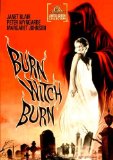| Reviews & Columns |
|
Reviews DVD TV on DVD Blu-ray 4K UHD International DVDs In Theaters Reviews by Studio Video Games Features Collector Series DVDs Easter Egg Database Interviews DVD Talk Radio Feature Articles Columns Anime Talk DVD Savant Horror DVDs The M.O.D. Squad Art House HD Talk Silent DVD
|
DVD Talk Forum |
|
|
| Resources |
|
DVD Price Search Customer Service #'s RCE Info Links |
|
Columns
|
|
|
Burn, Witch, Burn! (Night of the Eagle)
"Do you believe?"
Ranks right up there with the celebrated Night of the Demon. M-G-M's fun, fun M.O.D. (manufactured on demand) line of discs, the Limited Edition Collection (available via Amazon.com), has released Burn, Witch, Burn!, the American International Pictures title for the 1962 U.K. production, Night of the Eagle, starring Janet Blair, Peter Wyngarde, and Margaret Johnson. Featuring an intelligent, spooky script by horror masters Richard Matheson and Charles Beaumont (with an apparent uncredited assist by George Baxt), and tense, scary direction by Sidney Hayers, Burn, Witch, Burn! is a superlative witchcraft shocker you need to see. A suitably creepy trailer is included in this nice-looking widescreen transfer.
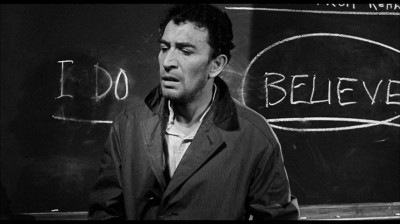
Hempnell Medical College, 1962. Psychology teacher Norman Taylor (Peter Wyngarde) is trying to convince his students that superstition and witchcraft is the bunk; modern science with its A-bombs is far more magical (and frightening) than a genie in the lamp, as he puts it. However, no one seems to have told his wife, Tansy (Janet Blair), about the illegitimacy of the supernatural in the face of cold, scientific fact, for she is a witch, you see. And when Norman finds this out and demands she stop her practice, she flips out, telling him that she can no longer protect him from the evil that surrounds him at the college. Now, Norman thought that only petty office politics posed a threat to him in the halls of Hempnell College; as the new teacher on the block, Norman's quick rise to the top has caused many in the department to view him with unreserved jealousy―particularly the wives of the male faculty, such as Flora Carr (Margaret Johnston), or Evelyn Sawtelle (Kathleen Byron), or Hilda Gunnison (Jessica Dunning). However, once Tansy is made to burn all her protective talismans, forces―evil forces, perhaps?―go to work on Norman's smug belief in the superiority of the "known" world...with terrifying results.
MOVIE-RUINING PLOT SPOILERS WARNING!
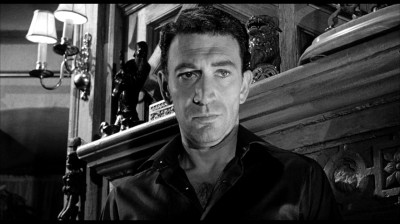
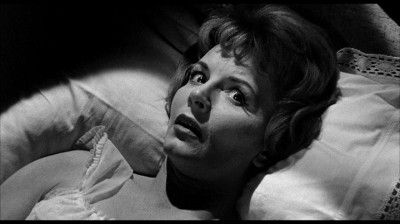
Except for an anonymous 1962 New York Times review I found on the web praising Burn, Witch, Burn!, my own source books indicate that very few contemporary critics found the movie favorable...if they managed to see it at all, since AIP dumped it on the bottom of a double-bill with another Richard Matheson-scribed horror outing, Tales of Terror, directed by Roger Corman. Perhaps those that did see this American release version of Anglo-Amalgamated's Night of the Eagle were instantly put off by that hilariously bad opening narration, over a black screen, where Paul Frees preps the viewer, spoofily-intoning, "I am now about to dispel all evil spirits that may radiate from the screen during this performance!" before he burbles a few made-up incantations, finishing with, "And now...with a free mind and a protected soul, we ask you to enjoy Burn, Witch, Burn!" (you just know that Arkoff had something to do with that silly tagged-on opening). Most serious movie fans can read those words with Frees' inimitable voice in their head (such was his omnipresence in movies and TV at the time), so you can imagine how grumpy critics, many of whom weren't attuned yet to see efforts from this genre as "serious" works, must have felt when they thought they were sitting down to a William Castle film instead of a something more akin to Jacques Tourneur and Val Lewton (and I'm not knocking Castle―I love his stuff). Because what follows is a one of the more remarkable examples of the genre from the 1960s, a classic that deserves as much cult credibility as the better-known Night of the Demon.
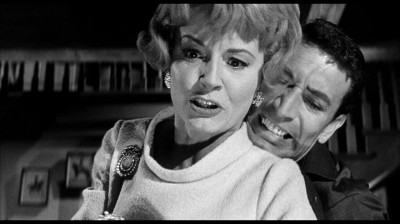
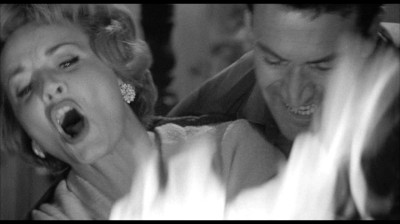
Right from the opening credits, you get the feeling that Burn, Witch, Burn! is going to be different. As the genuinely spooky, driving music of composer William Alwyn plays over the credits, a baleful, unmoving close-up of an eye hypnotizes you, until you think it's changing somehow, becoming meaner, more demonic...until you realize it's just your mind playing tricks on you after staring at an object too long (it helped, too, that I watched Burn, Witch, Burn! not on a sunny Saturday morning, but late on a Friday night, with a Central Casting-directed thunderstorm right outside by dark home theater). Indeed, that opening credit illusion is a proper metaphor for the entire film: are we seeing what we think we're seeing? And if so...what are we seeing? Skipping any attempts at ponderously setting up the characters' backstory through exposition or worse, flashbacks, Burn, Witch, Burn! dives right in, showing Norman boldly asserting, "I Do Not Believe" on his classroom blackboard, insisting to his students that those four simple words are enough to combat and destroy the false forces of the supernatural, witchcraft, superstition, and so-called psychic powers. Declaring that anyone who believes in such rot is exercising a "morbid desire to escape from reality," Norman offers that such whimsy is just a "futile attempt to control one's environment from the forces of nature." With such an unwavering, recalcitrant viewpoint shoved in the viewers' faces right up front, Burn, Witch, Burn! is just begging us to see the arrogant Norman shown up as a fool―a man blinkered by facts who trusts the relatively entity called "science" over the world's oldest "religion," as it is put later in the movie.
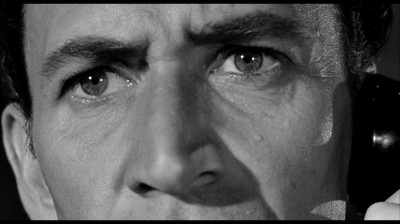
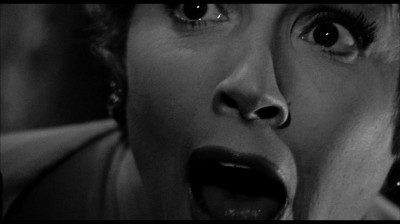
Almost immediately, then, director Sidney Hayers (the marvelous Circus of Horrors, Payroll), working from a script, based on Fritz Leiber's masterpiece, Conjure Wife, by Richard Matheson (I Am Legend, The Night Stalker) and Charles Beaumont (The Twilight Zone's The Howling Man and Printer's Devil, The 7 Faces of Dr. Lao, The Masque of the Red Death), with a final assist by George Baxt (Circus of Horrors, Payroll), begins to tighten the screws, throwing out an increasing number of red herrings and shock effects, both audio and visual, while adding disconcerting, swooping close-ups of the intense stars as the bric-a-brac of his chiaroscuro-lit mise-en-scene becomes more cluttered, more claustrophobic, more threatening. Burn, Witch, Burn! is remarkable, really, for its sustained level of tension―aided immeasurably by the performances that are executed with deadly seriousness―as Hayers uses beautiful Janet Blair's face as a white plane of fear, a frightening prop he shoots again and again as we see her eyes either darting off to the sides, trying to see the demons she knows lurk in the shadows around her, or even more frightening, when they stare straight out at us from a mask of terror (my all-time favorite, Peter Wyngarde, is also perfectly cast here: arrogant and smug when safely ignorant of events around him, and then gradually unhinged and terrified by the "reality" of the situation―a terrific starring role for Wyngarde before he went delightfully camp). Aided by the deep-focus, evocative cinematography of Reginald Wyer and the sharp, blunt editing of Ralph Sheldon, Hayers is able to deliver some stand-out shocker moments throughout the film, from the beautifully-designed assault on the apartment by an unseen (but not unheard) demon, or the car chase that results in one of the best on-screen fakes of a head-on collision I've seen from that period, to the final, desperate assault by the college's giant stone eagle, come to life (or is it?) and attacking Norman as he fails to find shelter from this terrifying beast―a sequence as good or better than any similar one in Night of the Demon (I also love the idea of seeing Tansy's foggy P.O.V. as she's carried around in her trance―that felt far more "modern" than 1962).
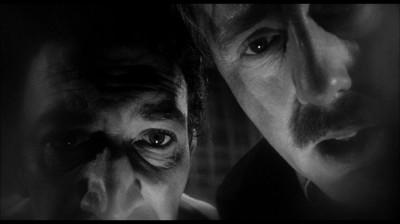
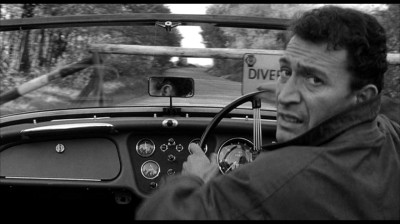
As impressive as Hayers' hold on the material is, the screenplay is so cunningly crafted that you're never really sure if the movie is stating "yes" or "no" on the existence of witchcraft. The beauty of Burn, Witch, Burn! is that you can go back and look at each scene of supposed supernatural activity...and explain it away logically and rationally. It's like a game where you can see both sides of the mirror, reflecting back what you believe. Even better, and something that seems to have been missed by supporters of the film: you can go back and look at all the uneventful, "rational" moments in the film...and see supernatural activity in them. The opening scene is a perfect example. If you believe the supernatural aspect of the story, bad luck doesn't begin to befall Norman until he forces Tansy to burn all their protective talismans. That's when pretty Margaret Abbott (Judith Stott) falsely accuses him of rape (she can't explain why she did it other than she irrationally hates him―such is the power of the witch that controls her, and angry boyfriend Fred Jennings (Bill Mitchell) pulls a gun on him in his office. But couldn't that opening scene during Norman's lecture already indicate witchcraft was at work, with Margaret openly flirting with Norman, and Fred already seething irrationally at the smug Norman? Could they already be under the powers of the villainous witch, and held just in check by Tansy's protective powers?
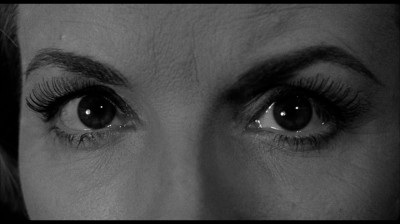
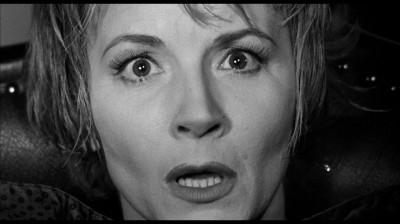
And now that we started nosing around it: what exactly is going on in Burn, Witch, Burn!? Is it a beautifully stylized fable of ancient witchcraft delivered via modern innovations (a nice metaphor for Norman and Tansy's relationship: she believes in magic; he believes in technology and science)? Are Norman and Tansy being stalked by a demon that inhabits their phones and their tape recorders and even their black cat, conjured up by a vengeful colleague bent on destroying Norman? Or are they being hypnotized through subliminal noises and prompts over their phone and tape recorder (that grating sound on the tape and phone that only Norman and Tansy seem to hear)? Is overwhelming, blood-curdling terror the reason Norman "hallucinates" at the end of the picture, thinking a stone eagle has come to life to rip him to shreds? Is he hallucinating? Or is he under an actual hypnotic spell? After all...everything is put right when he erases the "not" on his "I Do Not Believe" message on the blackboard; the eagle is back on its stone perch, the door it smashed through is magically repaired, and Norman's coat is no longer in tatters. Is this the force of evil...or is Norman mentally unhinged? When a small little black and white English horror movie can make you start thinking that nothing is truly explained in its narrative―and delightfully, disturbingly so, for that matter―when it can make you go back and wonder just what exactly you saw, while genuinely making you scared...then you know you've seen something quite special.
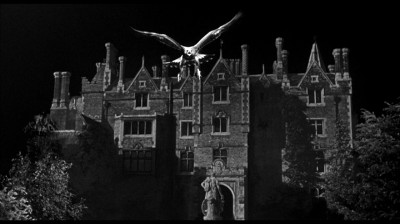
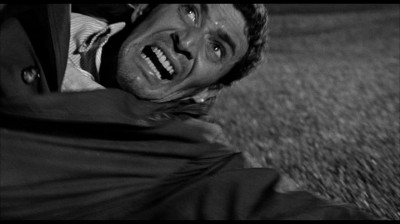
The DVD:
The Video:
The anamorphically-enhanced, 1.78:1 widescreen black and white transfer for Burn, Witch, Burn! did appear grainy at times...but only a few times. Otherwise, it was quite nice, with solid blacks that held, excellent contrast values, and a good gray scale. Image was sharp for the most part. Nice.
The Audio:
The Dolby Digital English mono audio soundtrack was re-recorded with some heft. All dialogue was fat and clear. No subtitles or close-captions available.
The Extras:
An original trailer has been included; you're seeing more and more of those included on these M.O.D.s.
Final Thoughts:
Superlative shocker: expertly directed, beautifully constructed, and scintillatingly shot. Janet Blair's beautiful face is used as a frightening prop, while Peter Wyngarde believably goes from smug and arrogant to unhinged with fear in this remarkable tale of modern-day witchcraft. It surely belongs with the absolute best of the genre. On content alone, Burn, Witch, Burn! deserves our highest ranking here at DVDTalk: the DVD Talk Collector Series award.
Paul Mavis is an internationally published film and television historian, a member of the Online Film Critics Society, and the author of The Espionage Filmography.


|
| Popular Reviews |
| Sponsored Links |
|
|
| Sponsored Links |
|
|
| Release List | Reviews | Shop | Newsletter | Forum | DVD Giveaways | Blu-Ray | Advertise |
|
Copyright 2024 DVDTalk.com All Rights Reserved. Legal Info, Privacy Policy, Terms of Use,
Manage Preferences,
Your Privacy Choices | |||||||









